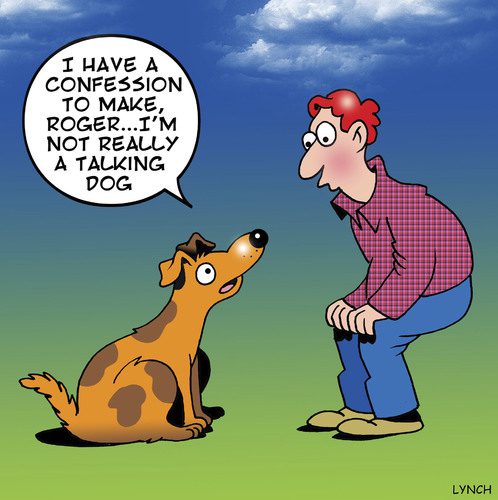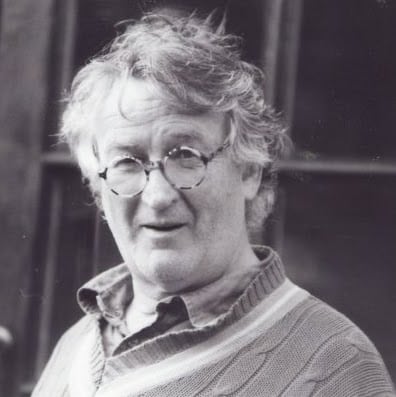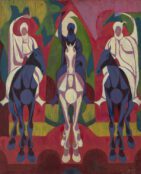What would they say, who would they refer to and are their directions credible.
I – A much ado about mammals (and other beings)
Much ado is made of language and its spread across the various species of animal life. Some simply presume there to be language amongst animals beyond the human. Having presumed its existence, they move to conduct empirical research on, for instance, regional dialects in pigeons, pigs, or penguins. What – apart from optimism, a modicum of anthropomorphism and a sentimentality toward animals, pursuant upon anthropomorphism – encourages such a view?
Where’s the evidence?
Certainly there is reliable evidence that animals call to each other, soliciting attention or, more urgently still, warning others in the group of imminent danger. Here is Bob Mortimer, in an episode of Would I Lie To You?, during which he describes two different duck calls:
When we speak of animal language we tend to think of the calls they make to each other and try to understand how that might best fit in with the patterns of their lives. We do not think, for instance that animals can learn to speak English or, for that matter, whether we can come to speak ‘Duckish’. So, our conception of animal language already starts on a different footing from our conception of humans learning either a first or a second language.

II
Miserably, I now fetch Mortimer’s light-hearted example of two duck calls down to earth. The difference between ‘quack,’ and ‘FOX!’ and the coincidence of the utterance with the angle of the duck’s beak, is that each call performs a different role in the lives of this temporally present group of ducks. Is this, then, evidence of – even inconclusive support for – Duckish, a language spoken exclusively by ducks?
What’s the difference?
It seems evident that animals make noises in response to their immediate environment. In this, they call to each other to gather themselves (as noted above); or to signal present danger; thereby calling upon the group to disperse or to hide or to run. More domestically, my dog comes when she is called, responds excitedly to the sound, ‘Walk!’; she jumps on my bed and nudges her head against mine in the mornings to wake me up; and so this supports there being inter-species communication at some primitive level. Similar sorts of evidence can be gathered from pre-linguistic children. (I do not mean to beg any questions. I mean only that children who are not yet competent in their first natural language, seem able to enter into – at least to some degree – communicative behaviour.)
If there is a difference between communication ascribed to animals and pre-linguistic children at this primitive level and our fully fledged natural language, say English, it is that in speaking English we, more or less competent speakers, have mastered concepts which remain opaque to pre-linguistic creatures. But what does it mean to have grasped a concept?
Do animals think through concepts?
Mortimer in his delightful tale speaks of the difference between the angle a duck’s bill makes when ‘it goes, “Quack,”’ and the angle its bill makes when ‘it goes, “FOX!”’ The first is a sound, the second is a much noisier, call. So, absurdly, Mortimer has the duck make a noise, ‘FOX!’ which can easily be taken for the English word, ‘fox’. However, it is unlikely – how could we tell? – that the duck can discriminate between foxes and dogs. That is, there is no evidence that ducks have delineated concepts, such that it is correct for it to say ‘FOX!,’ rather than ‘DOG!’
Chimpanzees
Some have tried to study animals closer in kind to human beings in order to try and attribute language to another species.
“There are several historical attempts to teach animals human language; but untul 1966 no such attempts yielded positive results. Then R. A. and B. T. Gardner, in extensive studies carried out in America, considered the possibility that although primates might be unable (for anatomical reasons) to vocalize speech, perhaps they could learn to communicate by human sign language. So they set out to an eleven months old female chimpanzee – Washoe – the American sign language used by deaf people, Ameslan.
After fifty-one months Washoe had acquired 132 signs of Ameslan, being able to use them for indicting general classes as well as specific objects or events. Thus the sign for dog was used to refer to live dogs and pictures of dogs of many sizes, breeds, and colours, and for the sound of barking (Gardner and Gardner, 1978, p. 38). She would use the signs spontaneously, and it was estimated that her use of combinations of signs was comparable to that of the early word combinations of human children (…)
Although syntax is important in adult human language, sign order is much less in evidence in early child language, and is not important in the American sign language. So the application of syntax is hardly appropriate as a criterion for the chimpanzees’ sign language.” (Fouts & Fouts 1987 632)
The Gardners added four more chimpanzees in 1972 and , after seven months of exposure, one of them, Moja, had her first fours signs. These were, ‘gimme,’ ‘go,’ ‘drink,’ and ‘more’. But it is hard to get from such signs to language. Indeed, on occasion when I have drunk myself stupid, I can be heard crying, ‘Gimme drink. Go. Gimme more.’ But these are unreflective signs blurted from beyond the frontiers of reason – they provide a mere reaction to the decrepitude into which I have descended.
The sounds and signs of the chimpanzees correlate with immediate actions to be taken by the animal participant – rather as my dog can be taught to lift its paw or to lie down upon command. Such actions were taught to my dog with a treat as reward.
Prototypical language?
It is interesting to note the research compares chimpanzees to pre-linguistic children. However, it is not in contention that the signs the animals make and the signs the infants make are similar; nor is it contentious that the signs the infants make are prototypically linguistic.
Language, as it were, very likely grows from such communicative beginnings. Let us leave it moot as to whether a human brain is pre-configured to master language in the complex sense in which conceptualization is centrally involved. We also need to argue for the fact that centrally conceptualized language is something over and above the calls of animals and the pre-linguistic behaviour of children. What we seek here is a distinction between animal calls and other significant behaviour in response to environmental factors, on the one hand, and the rudiments of a complex language. Such a distinction will be, in itself, a conceptual distinction, available only to language speakers.
Wittgenstein versus Saint Augustine
Wittgenstein begins Philosophical Investigations with a critique of St Augustine’s view of language. He starts by quoting Augustine from, Confessions:
“’When they (my elders) named some object, and accordingly moved towards something, I saw this and I grasped that the thing was called by the sound they uttered when they meant to point it out. Their intention was shewn by their bodily movements, as it were the natural language of all peoples: the expression of the face, the play of the eyes, the movement of other parts of the body, and the tone of voice which expresses our state of mind in seeking, having, rejecting, or avoiding something. Thus, as I heard words repeatedly used in their proper places in various sentences, I gradually learnt to understand what objects they signified; and after I had trained my mouth to form these sounds, I used them to express my own desires.’” (Wittgenstein 1963 §1)
A little further on, Wittgenstein argues against the Augustinian view as follows:
“If we look at the example in §1, [above] we may perhaps get an inkling how much this general notion of the meaning of a word surrounds the working of language with a haze which makes clear vision impossible. It disperses the fog to study the phenomena of language in primitive kinds of application in which one can command a clear view of the aim and functioning of words.
A child uses such primitive forms of language when it learns to talk. Here teaching of language is not explanation, but training.” (Ibid., §5)
What’s so special about language?
So we might think that something like animal responses conditioned by reward, and children’s early acquisition of behavioural responses, including their first linguistic efforts, are, indeed, alike, at least in some respect. Bob Mortimer’s absurd account involves him making the warning cry, “Whiffa,” when he hears a car. “Whiffa,” is not part of any language but is a sign to abort the mission – at best a code. But codes are not languages. What is so special about languages? In the first case, they abstract from experience in order for us to make sense of it; rather than our merely reacting to the experiences our environment provides. German philosopher, Göttlob Frege, remarks,
“[W]ithout symbols we would scarcely lift ourselves to conceptual thinking. Thus in applying the same symbol to different but similar things, we actually no longer symbolize the individual thing, but rather what the similarities have in common: the concept. This concept is first gained by symbolizing it; for since it is, in itself, imperceptible, it requires a perceptible representative in order to appear to us” (Frege 1972 83f)
Displacement
Linguists refer to the application of language to the world apart from our present circumstances (the here and now) as “displacement”. Here is a module from University of Leiden.
Wittgenstein corresponded with both Frege and Bertrand Russell, each of whom worked on problems in mathematics and language; and whilst Frege and Russell worked independently of each other they shared their research and, constructively, posed problems for each other. Wittgenstein went to Cambridge in 1912/13. He then left and wrote the Tractatus during the war. He and Russell discussed it in 1919, and it was published in 1920. Frege, Russell and Wittgenstein represent a turning point in the logic of ordinary language. For two thousand years Aristotelian logic had set the standards of argument. What Frege and Russell worked on permitted a new ‘predicate calculus’ to augment Aristotle’s valid arguments.
C20 advancement in logic
The new predicate calculus relied upon a distinction between referring or naming and the sense of a word or phrase in predication. Simple one-place predicates work by attributing to one item some property which that item exhibits. Mortimer is quick-witted, takes one object in the world – the man Mortimer, and say of him that he exhibits quick-wittedness. But quick-wittedness is not an object in the world, even if Mortimer is.
Wittgenstein follows Frege, who had shown that language is not made up of simple parts that correspond to simple ‘atomic’ parts of the world. A word, for Frege, makes sense only in the context of a sentence. Sentences are the basic units of meaning. In this Frege replaces the Augustinian view of words as mere names, with a holistic approach to language and meaning.
Oxford philosopher Michael Dummett, in his seminal work on Frege, notes,
“[In a chapter entitled “Some Theses of Frege’s on Sense and Reference” the 9th thesis is:] Only in the context of a sentence does a word stand for anything. This thesis is not only propounded but heavily underlined, in Grundlagen, where the mistake of ignoring it is cited as the source of many philosophical errors…” (Dummett 1981 92)
In his recent review of Charles Taylor’s new book, The Language Animal (2020), philosopher, Jonathan Rée writes,
“Condillac regarded words as labels for entities we can already identify, whereas Herder realised that some things – loyalty, for example, or laws or promises – would not exist if we did not have words for them.
Taylor wheels out some of the heavy artillery of 20th-century philosophy – Martin Heidegger and Maurice Merleau-Ponty as well as Wittgenstein – to vindicate Herder against Condillac. The bleached language of the natural sciences could not supply us with its ‘disengaged’ representations of an objective world, he argues, if it was not situated in a colourful landscape of personal, impassioned and playful linguistic practice. (‘We couldn’t learn to write a treatise before we learned to converse,’ as he puts it.) Language grows over time not so much through the addition of new words as through the force of narrative and metaphor – a point illustrated by the classical idea of civic equality, which was transformed by the American and French revolutions, and by various socialist movements, before receiving further twists in the contemporary politics of sexual, religious, cultural and national identities. Language ‘changes our world’, in short: it ‘introduces new meanings into our lives’ and ‘opens us to the domain it encodes’.” (Rée 2020)
However, it is only really with the work of Frege and Russell that modern philosophy has placed the argument on a sound logical basis. Nevertheless, Nevertheless, Rée’s comments, on Charles Taylor’s review of the dispute, is concise and clear in its representation of language as holistic.
In An Introduction to The Philosophy of Language, the final chapter is given over to a discussion of Wittgenstein’s view of language and the lessons we are to learn from it. Michael Morris takes a view of Wittgenstein’s philosophy of language that aligns it to certain concerns of German philosopher Immanuel Kant. In his observations he notes that Wittgenstein’s conception of language meaning comes to us pre-structured. In his dispute with Augustine, Wittgenstein says,
“Someone coming into a strange country will sometimes learn the language of the inhabitants from ostensive definitions that they give him; and he will often have to guess the meaning of these definitions; and will sometimes get it right, sometimes wrong.
And now, I think, we can say: Augustine describes the learning of human language as if a child came into a strange country and did not understand the language of the country; that is, as if it already had a language, only not this one. Or again: as if the child could already think, only not yet speak. And ‘think’ would here mean something like ‘talk to itself’.” (Wittgenstein, 1958 §32)
Wittgenstein, according to Morris holds the following two claims to be true – and each sets out Wittgenstein’s opposition to Augustine (Morris 2007 301),
“(W1) It is only possible to identify an object as something fit to be named from the point of view of the speaker of the language.”
And,
“(W2) The world itself does not come already divided into objects fit to be named.”
As Rée puts it, in discussing Frege,
“Number, in other words, is not an objective property in the way that colour is: ‘I can point to an individual patch of colour without saying a word’, as Frege put it, ‘but not to an individual number.’ We are obliged to conclude that number belongs neither to the “object” itself, nor to an “agglomeration’, and that it varies with our point of view, or how we choose to count.” (Rée 2019 484)
The Tractatus is composed of numbered paragraphs, some only consisting of a short sentence. It opens with,
1. The world is everything that is the case.
1.1. The world is the totality of facts, not of things. (Wittgenstein 1922)
These two opening sentences commit Wittgenstein to a view that only language speaking animals can grasp the world. This follows from the claim that ‘the world is the totality of facts’. For, simply put, facts exhibit a linguistic structure. Earlier on in this essay, I questioned whether ducks could distinguish between a fox and a dog – whether they had the conceptual tools to make such a distinction. That question is risen again each time we want to express a belief on behalf of animals. Does the cat think the mouse has run under the sofa? How could it think that, if it has no means of sorting under concepts? Certainly cats think – but their thoughts are nothing like ours.
“5.6.1.1.The limits of my language mean the limits of my world.” (ibid.)
Animals, being sentient creatures, enjoy mental lives. It is their inability to structure experience under conceptual sortals that prevents them from entering into language and its advantages. As a last word from Wittgenstein, I give you:
“If a lion could talk, we could not understand him.” (Wittgenstein 1958 223e)
References:
Dummett, M., (1981) Frege: Philosophy of Language, London: Duckworth
Frege, G., (1972) “On the Scientific Justification of a Begriffsschrift,”in Conceptual Notation and Related Articles, ed. by T. W. Bynum.
Fouts, R. S. & Fouts, D. H., (1987) “Primate Language,” in Gregory, R. L., The Oxford Companion to the Mind, Oxford University Press
Morris, M., (2007) An Introduction to the Philosophy of Language, Cambridge University Press
Rée, J., (2019) The Invention of Philosophy in English, London: Allen Lane
Rée, J., (2020) The Guardian Review online. Accessed on 09/05/2020 at: https://www.theguardian.com/books/2016/apr/27/the-language-animal-the-full-shape-of-human-linguistic-capacity-charles-taylor-review
Wittgenstein, L., (1922) Tractatus Logico-Philosophicus, London: Routledge & Kegan Paul
Wittgenstein, L., (1958) Philosophical Investigations, London: Basil Blackwell
Would I lie to You? Series 13 Episode 5, BBC. Accessed on 08/05/20 at: https://www.youtube.com/watch?v=yIm7SiP8ah4
Featured image: After the hunt, 1870, by David Neal (1838-1915) Wikicommons

Ed studied painting at the Slade School of Fine Art and later wrote his PhD in Philosophy at UCL. He has written extensively on the visual arts and is presently writing a book on everyday aesthetics. He is an elected member of the International Association of Art Critics (AICA). He taught at University of Westminster and at University of Kent and he continues to make art.






















